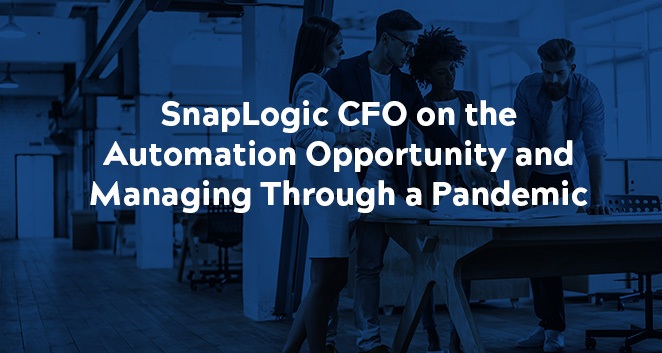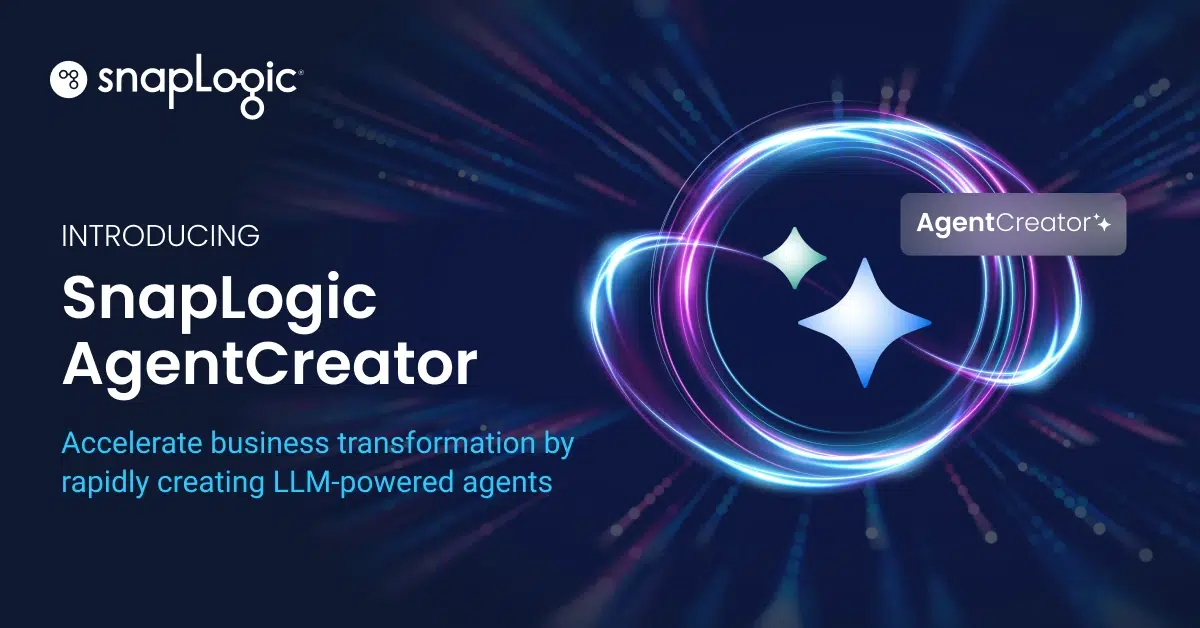SnapLogic CFO Elizabeth Loar recently spoke with Rob Sverbilov, Senior Director at financing firm Golub Capital, as part of Golub’s SaaS Talk series. The two discussed the expanding integration and automation market, how SnapLogic and its customers have managed through the pandemic, and what a CFO wants from a financing partner.
Keep reading below for the full conversation. This Q&A was produced by Golub Capital and first appeared here on their website.
Golub Capital’s SaaS Talk with SnapLogic CFO Elizabeth Loar.
Question: SnapLogic is at the leading edge of the enterprise Integration Platform as a Service (iPaaS) business. What are SnapLogic’s key competitive advantages in this area of significant growth?
Elizabeth Loar: Fast, agile organizations understand that integrating disparate systems and automating core processes are critical to accelerating business growth and success. This was true before the pandemic, but is even more so now. The market for application and data integration continues to evolve and grow, and research and advisory company Gartner has projected that the iPaaS market will grow to over $5.6 billion by 2024. The exciting thing for SnapLogic is that beyond iPaaS, there is an estimated total available market opportunity of around $50 billion for SnapLogic’s platform in data engineering, data integration and application integration.
This past year, we have seen our customers deal with larger, more complex, and more essential integrations and automations needed to run mission-critical processes across the enterprise. Leading organizations —including Adobe, AstraZeneca, Box, Emirates, Schneider Electric, and Wendy’s — trust SnapLogic to handle their enterprise integration needs. SnapLogic is the only platform that provides a single, unified platform for all integration projects: application integration, data integration, API management, B2B integration, data engineering. We offer a simple, intuitive, self-service interface together with a powerful, scalable, enterprise-grade platform. We have powerful, industry-leading AI capabilities to accelerate productivity and time to value. We also provide automation capabilities that streamline end-to-end business processes —such as hire-to-retire and order-to-cash — eliminating manual, repetitive activities, and freeing up business teams to focus on strategic projects.
Question: SnapLogic recently commissioned a study by Forrester that highlights the ROI that enterprises may experience by using your services. As CFO, how do you think about ROI for SnapLogic itself, and how to get the optimal impact from the capital you invest in the business?
Loar: Value and ROI can take many forms. As Forrester concluded in their Total Economic Impact ™ report, companies using SnapLogic realize an average ROI of 498% over a three-year period, with the platform paying for itself in less than six months. What’s more, the average customer accrues quantified benefits of $3.9 million, consisting of reduced cloud infrastructure costs, improved developer productivity, and increased revenue from net-new business initiatives.
As a CFO, I look at the same types of metrics when funding new projects or initiatives. What’s the short- and long-term capital investment and/or anticipated savings, what’s the impact on our existing team and resources, what productivity and time to value gains can we expect, and how soon before we start seeing the benefits or return on investment? Data is at the heart of all of this — we don’t make any important financial decision that isn’t backed up and supported by data.
Question: You became CFO in February at the onset of one of the most uncertain economic periods in recent history. What has surprised you most about this period from a business perspective? Any lessons learned?
Loar: I’ve been overseeing the finance function at SnapLogic for a few years now, most recently as CFO. While the pandemic took all of us by surprise, I’m grateful to be a part of this company and this industry. SnapLogic is fortunate to be a SaaS company focused on the enterprise. We have incredibly low customer churn, which has provided much-needed stability and far less volatility than most other industries, and the recurring revenue model of our business allows for a certain level of predictability during uncertain periods, from which my peers in other sectors might not benefit.
It’s also been reaffirming to see that our product can be instrumental in helping our customers manage through these tough times and come out stronger on the other side. Integration and automation tools are essential, especially in these times, for any company that prizes speed, agility and scale.
We’ve experienced periods of business disruption before COVID-19, each of them marked by unexpected challenges and new opportunities. While some might be inclined to be cautious and step on the brakes, the leaders of tomorrow see opportunities. We’re taking this to heart at SnapLogic. I’m grateful to be a part of a company that is using this time of disruption to step on the gas and move forward with confidence and optimism — for ourselves, as well as for our customers.
Question: What factors do you weigh when considering your financing options and how to best ensure the company’s funding is aligned with the goals of the business?
Loar: There are a number of factors we consider when teaming up with a new financing partner, but first and foremost, we look for a strong firm that truly understands our business and shares the same values and long-term perspective as our founders and management team. It has to start here.
Aside from the financing itself, we also always look for a proven and respected operational team we can learn from and an extended global network we can leverage. Golub Capital has been a great partner to SnapLogic across all fronts.
Questions: How has the market for iPaaS solutions fared in 2020, and how do you see the market for SnapLogic’s products and services evolving over the next 24 months?
Loar: Demand for app and data integration platforms was booming before the pandemic and has only accelerated in 2020. I don’t see a slowdown anytime soon.
Leading organizations are embracing the cloud, data and AI to rethink and rewire their businesses. Manual, repetitive tasks are being replaced by automated, digital ones. Data flows freely, and business processes run without interruption. Skilled workers are freed up to focus on strategic projects that deliver real business value. As a result, these organizations can see around corners, flex and adapt as needed, and run faster in order to scale up and seize the moment, especially in times of rapid change.
Going forward, we’re doubling down on our strengths, including the low-code, self-service, AI-powered nature of our platform. The more we can automate the integration process for our customers, and the more people across the organization can leverage our platform to connect their apps and data, the faster our customers can achieve their business goals.
Questions: What area of innovation is SnapLogic most excited about, and where do you see the most opportunity from an end-market perspective?
Loar: We’re incredibly excited about the opportunity around enterprise automation. For us, it’s about helping our customers efficiently connect the enterprise, empower their people with seamless processes and better data and enable timely insights to make the right decisions, dramatically faster. Applications and processes are optimized to automatically share data and work together holistically to achieve the goals of the business. In the automated enterprise, data plus AI plus humans equals scale and speed that cannot be achieved by humans alone.
Enterprise automation makes possible what every organization wants: a single source of truth for data-rich decisions, agile innovation that delivers products and services to market faster, exceptional experiences for customers, partners, and employees, and amazing business results —higher revenue, profit, market share, and competitive standing.
Question: What advice would you give the new CFO of a growing SaaS company?
Loar: It’s important to surround yourself with a leadership team that is truly data-driven and metrics-obsessed, across the entirety of the business. As a finance leader, you need to be able to track and measure everything you do. It’s a delicate balance between investing for growth but also tracking the returns, particularly in areas that are underperforming, so you can quickly shift to areas that will drive better and faster growth. This speed and agility, enabled by real-time data and agreed metrics, is fundamental to success.











